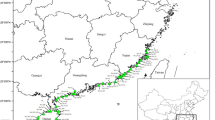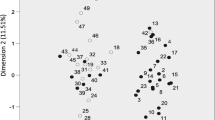Abstract
Given the impact of climate change on the availability of water resources, it becomes necessary the use of plant species well suited to planting on dryland sites. Eucalyptus cladocalyx, a native tree of South Australia, is capable of growing under relatively dry environments and saline soils. Two hundred twenty simple sequence repeat (microsatellites) markers, from a consensus linkage map of Eucalyptus, were selected to examine genetic diversity and population structure in a collection of E. cladocalyx introduced to southern Atacama Desert, Chile. A total of 130 microsatellites were successfully amplified, some of which are associated with quantitative traits of interest in Eucalyptus. Genetic analysis revealed a total of 457 alleles, ranging from 2 to 8 alleles per locus. A moderate level of genetic diversity (He = 0.492) and differentiation (FST = 0.086) was found among the populations. Mount Remarkable and Marble Range showed the highest and lowest level of genetic diversity, respectively. The Bayesian clustering analysis revealed three homogeneous genetic groups confirming that the individuals of E. cladocalyx from natural forest are highly and significantly structured. These results provide a novel information for the development of breeding strategies in E. cladocalyx by using marker-assisted selection in regions with low rainfall patterns.

Similar content being viewed by others
Abbreviations
- AR:
-
Allelic richness
- FST:
-
Genetic differentiation
- MCMC:
-
Markov chain Monte Carlo
- QTL:
-
Quantitative trait loci
- SSR:
-
Simple sequence repeat
References
Arriagada O, Mora F, Dellarossa JC, Ferreira MF, Cervigni GD, Schuster I (2012) Bayesian mapping of quantitative trait loci (QTL) controlling soybean cyst nematode resistant. Euphytica 186:907–917
Ballesta P, Mora F, Contreras-Soto R, Ruiz E, Perret S (2015a) Analysis of the genetic diversity of Eucalyptus cladocalyx (sugar gum) using ISSR markers. Acta Sci Agron 37:133–140
Ballesta P, Mora F, Ruiz E, Contreras-Soto R (2015b) Marker-trait associations for survival, growth, and flowering components in Eucalyptus cladocalyx under arid conditions. Biol Plant 59(2):389–393
Balloux F, Lugon-Moulin N (2002) The estimation of population differentiation with microsatellite markers. Mol Ecol 11:155–165
Brondani RPV, Brondani C, Tarchini R, Grattapaglia D (1998) Development, characterization and mapping of microsatellite markers in Eucalyptus grandis and E. urophylla. Theor Appl Genet 97:816–827
Brondani RPV, Williams ER, Brondani C, Grattapaglia D (2006) A microsatellite-based consensus linkage map for species of Eucalyptus and a novel set of 230 microsatellite markers for the genus. BMC Plant Biol 6:20
Brooker MIH (2000) A new classification of the genus Eucalyptus L’Her. (Myrtaceae). Aust Syst Bot 13:79–148
Bush D, Thumma B (2013) Characterising a Eucalyptus cladocalyx breeding population using SNP markers. Tree Genet Genomes 9:741–752
Bush D, Jackson T, Driscoll J, Harwood C (2009) Australian low rainfall tree improvement group: metadata from measures of hardwood tree improvement trials in southern Australia. Rural Industries Research and Development Corporation. https://rirdc.infoservices.com.au/downloads/09-078. Accessed 30 Sept 2015
Bush D, Mc Carthy K, Meder R (2011) Genetic variation of natural durability traits in Eucalyptus cladocalyx (sugar gum). Ann For Sci 68:1057–1066
Bush D, Kain D, Kanowski P, Matheson C (2015) Genetic parameter estimates informed by a marker-based pedigree: a case study with Eucalyptus cladocalyx in southern Australia. Tree Genet Genomes 11:1–16
Cané-Retamales C, Mora F, Vargas-Reeve F, Perret S, Contreras-Soto R (2011) Bayesian threshold analysis of breeding values, genetic correlation and heritability of flowering intensity in Eucalyptus cladocalyx under arid conditions. Euphytica 178:177–183
Cappa EP, El-Kassaby YA, Garcia MN, Acuña C, Borralho NMG, Grattapaglia D, Marcucci-Poltri SN (2013) Impacts of population structure and analytical models in genome-wide association studies of complex traits in forest trees: a case study in Eucalyptus globulus. PLoS ONE 8:e81267
Chapuis MP, Estoup A (2007) Microsatellite null alleles and estimation of population differentiation. Mol Biol Evol 24:621–631
Clarke B, McLeod I, Vercoe T (2009) Trees for farm forestry: 22 promising species. Rural Industries Research and Development Corporation. https://rirdc.infoservices.com.au/downloads/09-015.pdf. Accessed 21 Sept 2015
Contreras-Soto R, Ballesta P, Ruiz E, Mora F (2015) Identification of ISSR markers linked to flowering traits in a representative sample of Eucalyptus cladocalyx. J For Res. doi:10.1007/s11676-015-0149-2
da Silva MN (2010) Extraction of genomic DNA from leaf tissues of mature native species of the cerrado. Rev Árvore 34:973–978
da Silva TA, Cantagalli LB, Saavedra J, Lopes AD, Mangolin CA, da Silva MDFP, Scapim CA (2015) Population structure and genetic diversity of Brazilian popcorn germplasm inferred by microsatellite markers. Electron J Biotechnol 18:181–187
De Lange WJ, Veldtman R, Allsopp MH (2013) Valuation of pollinator forage services provided by Eucalyptus cladocalyx. J Environ Manag 125:12–18
Dempster AP, Laird NM, Rubin DB (1977) Maximum likelihood from incomplete data via the EM algorithm. J R Stat Soc B 39:1–38
Dutkowski GW, Potts BM (2012) Genetic variation in the susceptibility of Eucalyptus globulus to drought damage. Tree Genet Genomes 8:757–773
Evanno G, Regnaut S, Goudet J (2005) Detecting the number of clusters of individuals using the software STRUCTURE: a simulation study. Mol Ecol 14:2611–2620
Feng S, Fu Q (2013) Expansion of global drylands under a warming climate. Atmos Chem Phys 13:14637–14665
Flint-Garcia SA, Thornsberry JM, Iv B (2003) Structure of linkage disequilibrium in plants. Annu Rev Plant Biol 54:357–374
Freeman JS, Whittock SP, Potts MB, Vaillancourt RE (2009) QTL influencing growth and wood properties in Eucalyptus globulus. Tree Genet Genomes 5:713–722
Gleadow RM, Woodrow IE (2002) Defense chemistry of Eucalyptus cladocalyx seedlings is affected by water supply. Tree Physiol 22:939–945
Goudet J (2001) FSTAT, a program to estimate and test gene diversities and fixation indices (version 2.9.3). Available from http://www.unil.ch/izea/softwares/fstat.html
Grattapaglia D, Kirst M (2008) Eucalyptus applied genomics: from gene sequences to breeding tools. New Phytol 179:911–929
Grattapaglia D, Vaillancourt RE, Shepherd M, Thumma BR, Foley W, Külheim C, Potts MB, Myburg AA (2012) Progress in Myrtaceae genetics and genomics: Eucalyptus as the pivotal genus. Tree Genet Genomes 8:463–508
Hartings H, Berardo N, Mazzinelli GF, Valoti P, Verderio A, Motto M (2008) Assessment of genetic diversity and relationships among maize (Zea mays L.) Italian landraces by morphological traits and AFLP profiling. Theor Appl Genet 117:831–842
Hedrick PW (2005) A standardized genetic differentiation measure. Evolution 59:1633–1638
Heidelberger P, Welch PD (1983) Simulation run length control in the presence of an initial transient. Oper Res 31(6):1109–1144
Jones ME, Shepherd M, Henry R, Delves A (2008) Pollen flow in Eucalyptus grandis determined by paternity analysis using microsatellite markers. Tree Genet Genomes 4:37–47
Kalia RK, Rai MK, Kalia S, Singh R, Dhawan AK (2011) Microsatellites markers: an overview of the recent progress in plants. Euphytica 177:309–334
Kirst M, Cordeiro CM, Rezende GDSP, Grattapaglia D (2005) Power of microsatellite markers for fingerprinting and parentage analysis in Eucalyptus grandis breeding populations. J Hered 96:161–166
Marcucci-Poltri SN, Zelener N, Traverso JR, Gelid P, Hopp HE (2003) Selection of a seed orchard of Eucalyptus dunnii based on genetic diversity criteria calculated using molecular markers. Tree Physiol 23:625–632
Marques C, Brondani RPV, Grattapaglia D, Sederoff R (2002) Conservation of microsatellite loci and QTL for vegetative propagation in Eucalyptus tereticornis, E. globulus, E. grandis and E. urophylla. Theor Appl Genet 105:474–478
Marshall TC, Slate JBKE, Kruuk LEB, Pemberton JM (1998) Statistical confidence for likelihood-based paternity inference in natural populations. Mol Ecol 7:639–655
McDonald MW, Rawlings M, Butcher PA, Bell JC (2003) Regional divergence and inbreeding in Eucalyptus cladocalyx (Myrtaceae). Aust J Bot 51:393–403
Meirmans PG (2006) Using the AMOVA framework to estimate a standardized genetic differentiation measure. Evolution 60:2399–2402
Meirmans PG, Hedrick PW (2011) Assessing population structure: F ST and related measures. Mol Ecol Resour 11:5–18
Missiaggia AA, Piacezzi AL, Grattapaglia D (2005) Genetic mapping of Eef1, a major effect QTL for early flowering in Eucalyptus grandis. Tree Genet Genomes 1:79–84
Mora F, Serra N (2014) Bayesian estimation of genetic parameters for growth, stem straightness, and survival in Eucalyptus globulus on an Andean Foothill site. Tree Genet Genomes 10:711–719
Mora F, Gleadow R, Perret S, Scapim CA (2009) Genetic variation for early flowering, survival and growth in sugar gum (Eucalyptus cladocalyx F. Muell) in southern Atacama Desert. Euphytica 169:335–344
Mora F, Castillo D, Lado B, Matus I, Poland J, Belzile F, del Pozo A (2015) Genome-wide association mapping of agronomic traits and carbon isotope discrimination in a worldwide germplasm collection of spring wheat using SNP markers. Mol Breeding 35:1–12
Moura JCMS, Araújo P, dos Santos Brito M, Souza UR, Viana JOF, Mazzafera P (2012) Validation of reference genes from Eucalyptus spp. under different stress conditions. BMC Res Notes 5:634
Myburg AA, Grattapaglia D, Tuskan GA et al (2014) The genome of Eucalyptus grandis. Nature 510:356–362
Nei M (1978) Estimation of average heterozygosity and genetic distance from a small number of individuals. Genetics 89:583–590
Nevill PG, Reed A, Bossinger G, Vaillancourt RE, Larcombe M, Ades PK (2008) Cross-species amplification of Eucalyptus microsatellite loci. Mol Ecol Resour 8:1277–1280
O’Reilly PT, Canino MF, Bailey KM, Bentzen P (2004) Inverse relationship between FST and microsatellite polymorphism in the marine fish, walleye pollock (Theragra chalcogramma): implications for resolving weak population structure. Mol Ecol 13:1799–1814
Peakall R, Smouse PE (2012) GenAlEx 6.5: genetic analysis in Excel. Population genetic software for teaching and research-an update. Bioinformatics 28:2537–2539
Pritchard JK, Stephens M, Donnelly P (2000) Inference of population structure using multilocus genotype data. Genetics 155:945–959
Raymond CA (2002) Genetics of Eucalyptus wood properties. Ann For Sci 59:525–531
Rice WR (1989) Analyzing tables of statistical tests. Evolution 43:223–225
Rousset F (2008) Genepop’007: a complete re-implementation of the genepop software for Windows and Linux. Mol Ecol Resour 8:103–106
Saavedra J, Silva TA, Mora F, Scapim CA (2013) Bayesian analysis of genetic structure of a Brazilian popcorn germplasm using data from simple sequence repeats (SSR). Chil J Agric Res 73:99–107
Sumathi M, Ramasamy Y (2014) Microsatellite resources of Eucalyptus: current status and future perspectives. Bot Stud 55:73
Vargas-Reeve F, Mora F, Perret S, Scapim CA (2013) Heritability of stem straightness and genetic correlations in Eucalyptus cladocalyx in the semi-arid region of Chile. Crop Breed Appl Biotechol 13:107–112
Woodrow IE, Slocum DJ, Gleadow RM (2002) Influence of water stress on cyanogenic capacity in Eucalyptus cladocalyx. Funct Plant Biol 29:103–110
Acknowledgements
The authors thank Mr. Augusto Gomes for providing the samples of E. cladocalyx. Osvin Arriagada thanks CONICYT for a doctoral fellowship (CONICYT-PCHA/Doctorado Nacional/año 2013-folio 21130812).
Funding
This study was funded by FONDECYT (Grant Number 1130306).
Author information
Authors and Affiliations
Corresponding author
Ethics declarations
Conflict of interest
Freddy Mora, Osvin Arriagada, Paulina Ballesta, and Eduardo Ruiz declare that they have no conflict of interest.
Electronic supplementary material
Below is the link to the electronic supplementary material.
Rights and permissions
About this article
Cite this article
Mora, F., Arriagada, O., Ballesta, P. et al. Genetic diversity and population structure of a drought-tolerant species of Eucalyptus, using microsatellite markers . J. Plant Biochem. Biotechnol. 26, 274–281 (2017). https://doi.org/10.1007/s13562-016-0389-z
Received:
Accepted:
Published:
Issue Date:
DOI: https://doi.org/10.1007/s13562-016-0389-z




